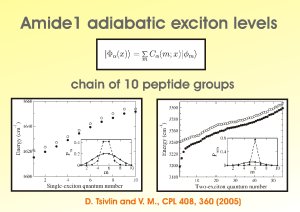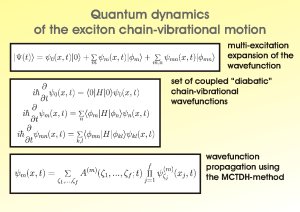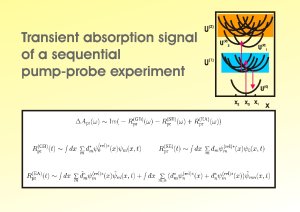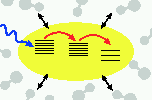Vibrational Excitons in Polypeptides
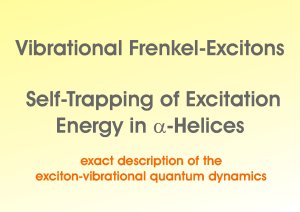 |
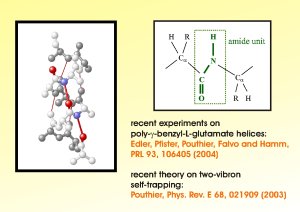 |
The ongoing progress in the field of ultrafast infrared spectroscopy
has brought new interest to the studies of ultrafast
vibrational dynamics
in biologically relevant molecular systems
also initiating various accompanying theoretical simulations.
In particular, the long--standing debate on the existence of
self--trapped vibrational states in alpha-helical polypeptides
has been reanimated.
Following the idea of the so-called Davydov soliton
proposed some three decades ago exciton self-trapping
in these systems has been
extensively studied theoretically.
However, an experimental proof for the existence of self-trapped
states in alpha-helices has been lacking until
recently. Using infrared femtosecond spectroscopy
the observation of self-trapped N-H first overtone stretching vibrations in
dissolved poly-gamma-benzyl-L-glutamate helices has been reported.
The interpretation of the transient absorption spectra (TAS) was mainly based
on recent theoretical work.
Within a linear chain model as well as a
three-dimensional model of an alpha-helical polypeptide
vibrational single and two-exciton self-trapped states have been obtained assuming a coupling to low-frequency longitudinal helix vibrations.
The two energetically lowest two-exciton self-trapped levels could be assigned to
the observed peaks in the excited state absorption part
of the TAS.
 |
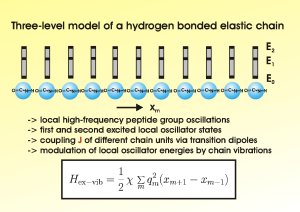 |
While these approaches directly aim at a calculation
of the spectrum of the high-frequency amide group vibrations dressed by low-frequency longitudinal
helix vibrations we suggested an alternative
computational scheme. Instead of carrying out different approximate canonical transformations of the original Hamiltonian we, first, computed the adiabatic single and two-exciton states of the system. They follow as overall eigenstates but with the longitudinal
helix coordinates treated as parameters.
These types of calculations resulted in an approximate picture
of the spectrum with the focus on single and double
amide I-excitation.
In a second step, the results have been improved
by a numerically exact solution of the complete time-dependent Schroedinger
equation. To study a sufficiently long chain we did not perform
calculations for the 3D helix structure but considered a model for
one of the three linear chains of hydrogen bonded amide groups.
Then, up to nine low-frequency coordinates of the longitudinal
amide group displacements could be considered.
A numerical solution of the respective Schroedinger
equation became possible by using the multiconfiguration
time-dependent Hartree
(MCTDH) method.
Within this method the total wavefunction is represented as a time-dependent
superposition of products of time-dependent single coordinate wave functions
(time-dependent Hartree products).
Based on the Dirac--Frenkel
variational principle, equations of motion are formulated for the expansion coefficients
as well as for the single coordinate wave functions.
Since the latter depend on time, they may be adapted
to the full wavefunction,
thus drastically reducing the numerical effort compared
to a standard basis set expansion
with time independent functions.
The energetically lowest single and
two--exciton state could be determined via imaginary time propagation
done within the MCTDH method.
Real time propagation of the complete wavefunction
enabled us to obtain the linear absorption spectrum and the TAS.
This has been achieved in
using the time-dependent formulation
of the absorption spectra. It offers the complete set
of single and two-exciton states coupled to the longitudinal helix
vibrations together with the oscillator strengths of linear
and excited state absorption.
Therefore, our treatment also improves other studies. Besides
the description of transitions into the different exciton levels our calculations also account for the multitude of satellites related to the longitudinal chain vibrations. Thus, a more realistic description of what has been observed in the experiment could be achieved.
Literature:
- D. Tsivlin and V. May:
Multidimensional Wave Packet Dynamics in Polypeptides.
Coupled Amide--Exciton Chain--Vibrational Motion in an alpha-Helix.
Chem. Phys. (2007), available online.
- D. V. Tsivlin and V. May:
Self-Trapping of the N-H Vibrational Mode in alpha-Helical Polypeptides
J. Chem. Phys. 125, 224902 (2006).
- D. V. Tsivlin, H.-D. Meyer, and V. May:
Vibrational Excitons in alpha-Helical Polypeptides:
Multiexciton Self-Trapping and Related Infrared Transient Absorption
J. Chem. Phys. 124, 134907 (2006).




